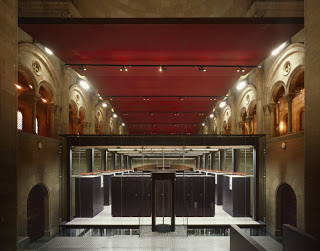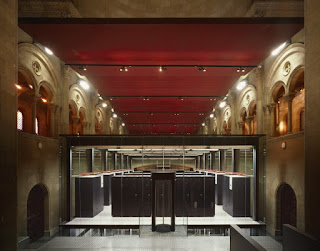Another still winter’s morning. I see birds shivering the garden outside my window. There is a very heavy mist, or it is raining, or both. There is not the slightest breeze; the air is completely still. If I open my window I can hear the water dripping from the drains, droplets falling from the leaves. The only colours I see are greys and greens and browns. I’m in — but no, I am not in Ireland, I am in Gotland. On Bergman’s island, it is the start of Andrei Tarkovsky’s film “The Sacrifice”.
Time has neither slowed down nor become irrelevant; it just that what one normally expects of time and event do not apply. A man tends a tree and speaks to child who does not respond; we see the branches of the tree against the sea’s blue waters. The landscape around him is flat and featureless. There are stones and rocks here; and around him are dunes and grass, a northern coastal landscape. The man’s monologue lasts almost twenty minutes, but we do not notice the passage of time. The man tells us a parable of a tree and a monk. The camera follows him and the child as he pushes his bicycle across the grassy, uneven ground towards his house. His monologue ploughs deeper and deeper, meaning supplanting meaning. The landscape fades away and there are only words. He says, throughout my life I feel as if I have been at a train station, waiting for the train to arrive. An event still to happen has yet to reveal itself.
The man returns to his house. His friends arrive to celebrate his birthday with him. But already there is something strange, a right angle that has become a curve, words which are out of joint. Their conversations are stylized, almost too full of meaning. Light enters his house in perfectly straight lines and we actually notice this. Like Antonioni, Tarkovsky composes each camera frame like a painting, no single thing is not in its absolutely correct location. Gifts are given, it is a birthday after all. We are told: no gift would be a gift unless a sacrifice was involved. Night falls. No — it doesn’t fall, it more correctly oozes through every corner of the house and removes almost all colour and texture from every object. Aeroplanes fly low overhead, but we do not see them, we simply hear the rushing, roaring sound metres above our heads. Danger is imminent. There is an announcement; we see the flickering light of the television on the lightless walls. The television says, in fact, that the war has started now, that there is nothing to be done. That we must prepare ourselves. But — explains our friend’s philosopher-postman — there is a way out. A sacrifice which can be made.
Outside the film, the real world has faded away. There is no cinema and there are no cinema seats. I am no longer in Paris in the Cinematheque Francaise. That is the strangest thing of all for me about watching Tarkovsky’s films, especially this one. If you can enter into the world, if you can be hypnotized by it, it is so completely unlike watching any other film. It is the nearest thing to dreaming whilst awake. It is clear that if you cannot become part of this universe, then perhaps these films seem eventless. You expect things to happen in certain way, for events to unfold in a manner you would expect. But here in the heart of “The Sacrifice” none of this applies.
The film is roughly divided into three segments. There is the first part comprising early afternoon and nightfall; then the night; and then the following morning. “The Sacrifice” is a film in colour, but the night-time sequences are filmed in a colour with no depth, unsaturated. In these scenes only the vaguest hints of colour remain. Now that such distractions are removed, objects and forms can take on their essential shapes. It is a further dream within a dream, and we know that in this particular Universe many things become possible which would not be possible in the light of day. For me this was perhaps the greatest part of the film, this creation of an alternate world in the dead heart of the night.
Unlike Tarkovsky’s other films, “The Sacrifice” yields it’s meaning to us relatively easily. At it’s core is a strong and profound belief in the possibility that there is a god to intervene for us. God manifests himself, but only to one man only. I would have thought that an old rational skeptic like myself would have been repelled by this, but this is Tarkovsky’s belief; I could most certainly accept that. I could even hope for a second that it might be even true, that it might be true in an instant other than an instant in the depths of night. It also should be said, however, that after these flat monochromatic images, Tarkovsky’s morning scenes are jarring and unpleasant; we find it hard to live in this particular space, and it seems difficult to imagine that both universes exist together. It makes us question the reality of what has happened before.
I should mention perhaps some details about the film, Tarkovsky’s last film. I should mention that the cameraman was Sven Nykvist, who worked with Bergman, as did many of the actors. That certainly contributes to the ambience of the film, the way it which it proceeds, the scenes and characterisations. The reason why I found the film so affecting perhaps is because of this way in which an imaginary, dream-like state is made real. That even in this universe there is a certain logic to be followed.
At the Cinematheque, as perhaps I have mentioned before, there are very few incidental interruptions other than The Film. It is a pure experience. After the last beautiful image faded from the screen, a tree silhouetted against the shimmering waters of the sea, the lights simply came on. I attempted to start a round of applause, but found only one taker, far away towards the front. Everyone else seemed too overwhelmed. People appeared to be waking from a trance; they rose from their chairs and put on their hats and coats with difficulty, slightly disorientated. The strangest of all, in that enormous room with hundreds of seats, there was almost total silence. No-one spoke, no-one wanted to disturb the spell. I made my own way through the Parisian night to my apartment. I wondered how long it would be before I could even begin to think about seeing another film, a film which I knew could not equal “The Sacrifice”.
Technorati Tags: cinema, tarkovsky

